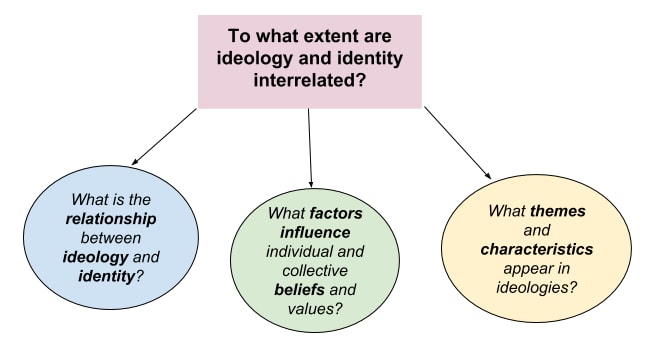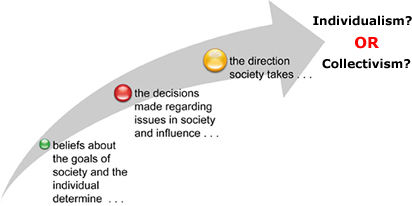UNIT 1: IDENTITY AND IDEOLOGY
| Site: | MoodleHUB.ca 🍁 |
| Course: | Social 30-1 RVS |
| Book: | UNIT 1: IDENTITY AND IDEOLOGY |
| Printed by: | Guest user |
| Date: | Saturday, 8 November 2025, 6:38 AM |
Description
Table of contents
- 1. OVERVIEW
- 2. Concepts and Terms
- 3. Influence
- 4. Beliefs and Values
- 5. Perspectives
- 6. Factors
- 7. Ideologies
- 8. Defining Ideologies
- 9. Characterisitics of Ideology
- 10. Themes of Ideologies
- 11. Quiz 1.1
- 12. Individualism Vs. Collectivism
- 13. Individualism
- 14. Collectivism
- 15. Quiz 1.2
- 16. Ideological Spectrum
- 17. Individualism as an Ideology
- 18. Collectivism as an Ideology
- 19. The Common Good
- 20. SUMMARY
1. OVERVIEW
Identity and Ideology
How do you see the world around you?
-
Do you believe people are inherently good and care about their fellow human beings?
-
Or do you think most people have a darker, selfish side that is kept in check only by rules and laws?
-
Do you think people should be responsible for their own well-being, or should society take responsibility for the care of the individuals that make it up?
-
Where do you fit in? What is your role as individual within society?
-
Why do you believe what you do? How much have your beliefs been shaped by those of others and to what extent do your beliefs guide your interactions with other members of society?
These questions all touch upon who you believe you are, what you value in life, and your attitudes toward the society you live in. In short, they are questions of identity and ideology.
In this unit, you examine these questions in greater detail, and explore the relationship between your own identity and ideology. As well, we consider the extent to which ideology can affect both individual and collective (group) identity.
Identity:
- How is your identity influenced by various factors such as culture, language, or gender?
- How does the your interaction with various groups, or collectives, influence who you are?
Ideologies:
- Ideologies are big ideas about the nature of people and society. They are a set of ideas or beliefs that help us categorize how people and groups see the world.
- This course focuses on where these ideas come from, and how they influence the actions of both individuals and groups. How do these sets of beliefs, like capitalism for example, help shape the society in in which we live?
- This unit introduces various ideologies, and explores the characteristics and themes that help define these belief systems.
This unit has 3 sections:
- What are beliefs and values?
- What is an ideology?
- Individualism, Collectivism and the Common Good
2. Concepts and Terms
Unit Question: To what extent should ideology be the foundation of identity?
Issue Question: To what extent are ideology and identity interrelated?
In this unit, you will explore the following big ideas based on questions arising from the issue question:
- What factors influence our individual beliefs and values?
- What are the characteristics and themes of an ideology?
- What are the relationships among individualism, collectivism, and the common good?
This is a list of new terms you will encounter in this unit.
belief
collective identity
collective norms
collectivism
common good
communism
conservative
extremism
identity
ideology
individualism
liberalism
moderate
nazism
personal identities
progressive taxation
reactionary
rule of law
self-interest
socialism
societal norms
value
worldview
3. Influence
Influence of Beliefs and Values on Identity

Look at the man on the left. He is a North Korean, posing in front of a communist monument in his own country. North Korea is a repressive state that controls its citizens tightly. Is this man's identity shaped by ideology? Is yours?
Although we are all individuals, with personal identities, we also have an identity as members of the various groups to which we belong. Our collective identity is also important.
Many factors influence our individual and collective beliefs and values. How does family and culture shape our beliefs? How does gender influence our values and the values of society? How do religion and spirituality shape us as individuals and as a group? Our environment and our relationship to it also influences our beliefs and values. The media also has a role, as does language. Finally, what role does ideology play? Ideologies are big ideas about the nature of people and society.
What factors influence your personal and collective beliefs and values?
4. Beliefs and Values
Your Beliefs and Values
As you read in your textbook pages above, individuals all have differing values and beliefs. These beliefs and values are influenced by many factors. Study the diagram below.

Now, consider the following statements regarding certain beliefs and values:
- Aboriginal people have more respect for the land than Canadians of other ethnic backgrounds.
- A woman is meant-both physically and psychologically-to be a wife and mother.
- Poor people live in poverty because they do not work hard enough.
- Individuals cannot be held responsible for their actions because they act as a result of their upbringing and genetics.
- A family consists of a man, a woman, and one or more children.
- Do you agree or disagree with these statements?
- What beliefs or values underlie these statements?
- Why or why not?
Statements such as these are assumptions. They are believed by people although they cannot be proven. In fact, the statements above can be considered ideological assumptions because they are based on more than a simple generalization, they are based on fundamental ideas about the nature of humanity and society.
Many people take for granted their core beliefs about how the world works. The problem with these assumptions is that they may not have been tested or examined in comparison to others.
In the remainder of this section, you will explore what influences your beliefs and values, which form the foundation of your personal ideology. By reflecting upon your own assumptions, hopefully you will become more aware of what influences other people's beliefs and actions.
5. Perspectives
Perspectives on Beliefs and Values
Ralph Waldo Emerson
John Stuart Mill
Bertrand Russell
Values and beliefs are highly personal and subjective. It is these ideas which form our personal ideology.
For example:
-
Do you believe we are born believing certain things, or we develop these over time?
-
When do you act according to your beliefs?
-
How strongly held are your beliefs? Would you die for them? Or, like Bertrand Russell, do you think your beliefs could be wrong?
Choose ONE of the statements presented in the coloured boxes above, and brainstorm some answers to the questions below. This will help you develop the analytical skills required for success in the course.
- What ideas about values and beliefs are presented in the source?
- Explain the author's ideas in your own words.
- To what extent do you agree with the perspective presented in the source?
6. Factors
Factors that Influence Beliefs and Values

The Role of Culture
A broad term, culture can include the values, religious or spiritual beliefs, language, food, clothing, marriage customs, and approaches to child raising that are shared by a particular group of people.Your culture is something you share with other people. Cultural beliefs and values are collective beliefs and values. You do not have an individual culture. As you have learned throughout your Social Studies education, culture is a complex term referring to the ways groups of people live and change over time. Your culture includes your heritage, ethnic background, religion, language, traditions, and ways of doing things.
Culture is learned and passed from one generation to the next. Each person is born into a specific cultural situation and absorbs the values, attitudes, and behaviour patterns of that culture.
Canada is a multicultural country. That means that it includes many groups of people with varied backgrounds and beliefs. In our pluralistic society, most Canadians value the diversity that comes with having many cultures living together in one country.
Many other factors influence beliefs and values, too.
Refer to the tutorial How to Take Notes
- You will not be asked to submit your notes for marking, but they will help your understanding of how these factors influence ideologies later on in the course.
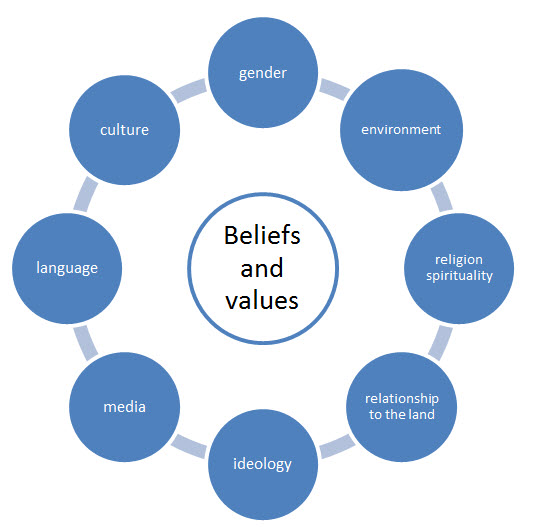
- "Family Influence", pages 32-33
- "Relating Gender to Beliefs and Values", pages 33-34
- "Religion and Spirituality", pages 34-36
- "Environment", pages 37-39
- "Relationship to Land", pages 39-41
- "Language and Ideology", pages 41-44
- "Media, Beliefs, and Values", pages 44-46.
7. Ideologies
What is an Ideology?

Consider the images of the statues. Do you see pieces of bronze, marble, concrete, and copper, or do you see representations of an idea or a set of ideas? For many people, these images are associated with sets of ideas for organizing human society. In other words, each is associated with an ideology.
Can you identify any of the ideologies represented by the statues? Communism? Liberalism? Fascism? This entire course examines the development and impact of these ideologies as symbolized by these statues.
In Section 1, you began to develop an understanding of how beliefs and values influence identity. In this section, we examine the characteristics and themes that make up these belief systems, otherwise known as ideologies.
What are some characteristics and themes of ideologies?
8. Defining Ideologies
Defining Ideology
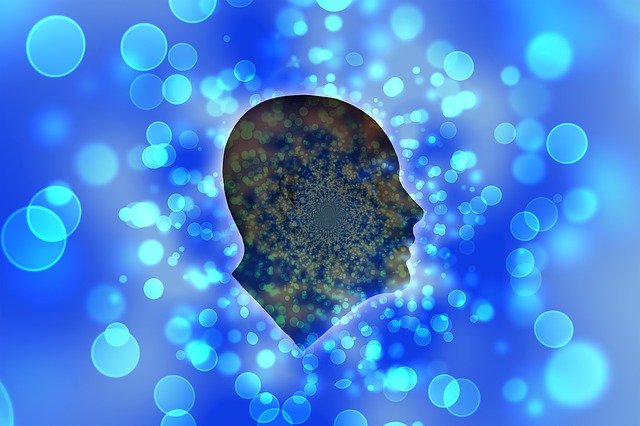
Ideology refers to the complex system of values and beliefs each of us holds about the world, the way it operates, and our place within it. Essentially, it helps us filter how we see, and then interact, with others.
By categorizing sets of beliefs into ideologies, we can discuss the similarities and differences that exist within our communities and between other societies.
Consider the following perspectives about ideology:
Victor Pross, British Columbia artist
Louis Giannetti, Understanding Movies
Harold Walsby, The Domain of Ideologies
Austin Cline
Elanna Starr, Villanova University
As you learn more about ideologies, in theory and practice, you will be closer to answering this issue question:
9. Characterisitics of Ideology
Characteristics of Ideology

- Human Nature: Whether most people hold essentially good or bad intentions
- Social Structure: How society should be structured based on equality or hierarchy.
- Interpretations of history: Whether history has lessons for present society, or should be disregarded as simply 'the past.'
- Visions of the future: What the future should look like in terms of political and economic structures.
The image to the right is a statue of Kim Il Sung, former dictator of communist North Korea. His memory is revered by many North Koreans who refer to him as the "Great Leader". The dates of his birth and his death are national holidays. North Korea abolished the position of president after his death so he could be named "the eternal President of the Republic". He is often connected to North Korea's totalitarian dictatorship.

Example: A Canadian Ritual
Ritual or traditions can also have an important role in reinforcing ideology. For example, the opening of a session of Canada's democratic Parliament is highly ritualized. On the first day of Parliament following an election, a person called
the Usher of the Black Rod walks ceremonially to the doors of the House of Commons and raps three times on the door with an ornate black rod. The newly elected Members of Parliament are invited to the Senate Chamber where the Queen's representative,
the Governor-General, reads the Speech from the Throne. All of this is based on the democratic tradition taken from the British.
In 1642, King Charles I entered the British House of Commons with the intention of arresting five MPs. Since then, neither monarchs nor their representatives have been allowed into the House of Commons in Britain or in Canada. Despite the fact that Canada's Governor-General is unlikely to order soldiers to arrest elected MPs, the ritual of excluding royal representatives is maintained because it symbolizes the freedom of the people's representatives to make laws without fear of retribution from an unelected king or queen.
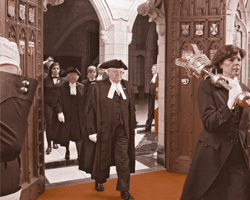
10. Themes of Ideologies
Various Themes in Ideologies
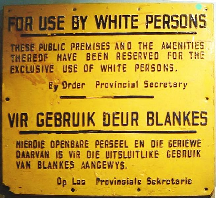
What is the basis for apartheid to be considered an "ideology"? How does apartheid exhibit the characteristics of an ideology you learned about in the previous section? Consider how South African apartheid answered the following questions:
- What is the nature of human beings?
- How should society be structured?
- How has history shaped our view of the present?
- How do we envision the future of South Africa?
All ideologies attempt to answer these types of questions and they often exhibit various themes. For example, apartheid was a political and economic system based on beliefs that society should be structured around race. This led to an unequal socio-political system of rigid laws based on racial superiority.
- nation
- class
- race
- relationship to the land or environment
- gender
- religion
- progressivism
Depending on a person or group's particular ideology, a theme or themes may be dominant. For example, adherence to a religious belief may be more important to Hutterites than loyalty to a nation. As the course progresses, you will learn more about how these themes have influenced ideologies in the past and the present.
- The nature of human beings: Under apartheid, the dominant society held the belief that white people were different, and in fact, superior to people from other races and that the two races could not live side by
side.
- Structure of society: Under apartheid, there was a very definite structure to society in which people of various races had various legal rights and various roles.
- Interpretation of history: The nation known today as South Africa was colonized by the Dutch and the British in the 1800s. Many Europeans settled in the area, establishing farms and mining operations. The Europeans
dominated the economy and politics of the area and claimed to believe that the African people would be better able to rule themselves under their previous system of tribal rule and that the European people would be better
off under their own form of democracy.
- Vision for the future: A future was envisioned in which there would be distinct geographic areas an\long with different laws and expectations for white and black South Africans.
Was progressivism a theme of apartheid?
Progressivism is a movement that supports better conditions for the average person. For a more specific definition, check out the course glossary, or read page 51 of your textbook.Under apartheid, the average white person enjoyed political, social and economic advantages compared to black South Africans. In part, this was based on the idea that black South Africans would live better in their own homelands, rather than integrated with whites or living in cities.
View this PowerPoint on Ideologies
11. Quiz 1.1
Please head to Quiz 1.1 in the unit tab and complete it.
12. Individualism Vs. Collectivism
Overview: Individualism and Collectivism
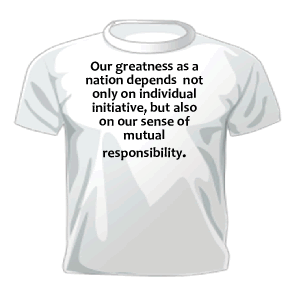
Ideologies can be primarily individualist or primarily collectivist. However, both forms of ideology share aspects of individualism and collectivism. Why? We are all individuals but we also are all members of society as a whole. Is it possible to have both individualist and collectivist values? Can people who believe in different ideologies live and work together within a nation? ...within the global community?
To help you understand how ideologies compare, they are often categorized along a line called a spectrum. See a basic spectrum of individualism and collectivism below.

As you work through the remainder of Unit 1 and Social Studies 30-1, you will continue to explore the interaction between individualism and collectivism.

As you read, think about the key differences between individualist and collectivist ideologies.
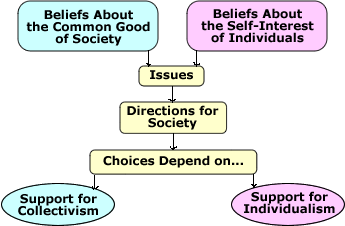
View this PowerPoint on Individualism and Collectivism
- What is individualism?
- What is collectivism?
- How are individualism and collectivism related to the common good?
13. Individualism
What is Individualism?

A belief in individualism is a foundation of ideologies such as liberalism, which is the main ideology found in Western democratic and economic systems today.
Individualism is an ideology based on the primacy of individual freedom. It is a belief in the freedom and worth of the individual over the security and welfare of the group. A supporter of the principles of individualism is referred to as an individualist. Supporters of individualism believe that self-reliance and personal autonomy create the best society.
Consider the T-shirt at the top of this page, then look at the quote below.
- What do they say about individualism?
- To what extent do you agree with the ideological perspective presented?
Albert Camus
Some values and beliefs behind individualism
- Each person is unique.

- Individuals are responsible for their own well-being, for meeting their own needs, and for making their own decisions and judgements.
- Individuals obtain meaning in their lives by working towards their own goals through their own work and through competition with others.
- Individuals' rights and freedoms are of the utmost importance and are protected by law.
Principles of Individualism
- Private Property (right to own)
- Rule of Law
- Individual Rights & Freedoms
- Competition
- Economic Freedom
- Self-Interest
Do you believe in following any of these principles?
- Nature of Man: People are essentially good, intelligent and able to succeed on their own
- Beliefs and Values: Belief in freedom and equality of opportunity
- Role of Government: Extremely limited
- Ideological Perspective: Extremely individualistic: Classical Liberalism
You will learn more about individualist-based ideologies in theory and in practice throughout this course.
14. Collectivism
What is Collectivism?

Many First Nations communities in Canada still share a belief in working for the good of the community. Historically, other societies have held collective ideologies. In many societies, acting for the good of the entire community rather for the good of each individual was necessary for survival. For the non-Aboriginal people who settled in early Canada, some of the principles of collectivism such as cooperation, collective interest, and collective responsibility helped them form safe and secure communities.
Collectivism is an ideology based on the importance of collective welfare. As an ideology, it represents a belief in achieving the goals of the group and the common good over the goals of any one individual. A supporter of the principles of collectivism is referred to as a collectivist.
Consider the two sources below.
-
What are they saying about collectivism?
- To what extent do you agree with the authors?
Mark Sanford
Woodrow Wilson
Some values and beliefs behind collectivism:
- Each person has unique skills and abilities that are used for the good of the community. Conformity to group norms, obedience, and harmony are expected.
- The community is responsible for everyone's well-being, for meeting their needs, and for making decisions and judgments.
- People obtain meaning in their lives through contributions to the larger community, working cooperatively towards common goals.
- Rights of the group take precedence; individual rights are secondary.
Principles of Collectivism
- Public Property
- Economic Equality
- Adherence to Collective Norms
- Collective Interests
- Cooperation
-
Collective Responsibility
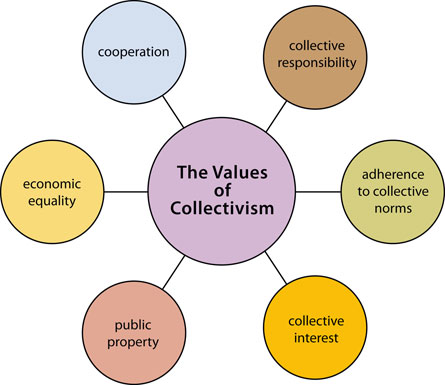
- Do any of these principles apply to you as a member of Canadian society?
- Do you believe in following any of these principles personally
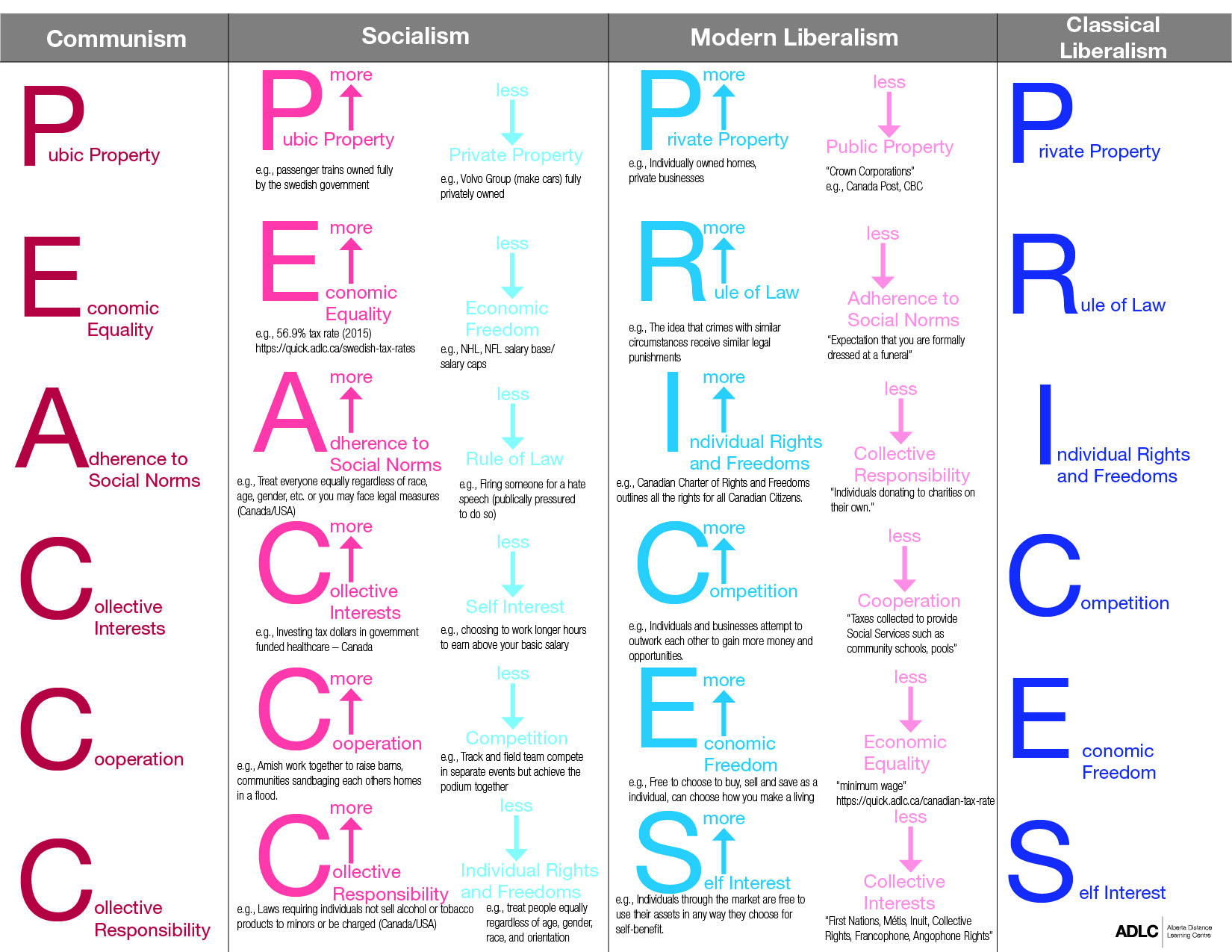
15. Quiz 1.2
Please go to the quiz link found in the unit tab for 1.2 and complete that.
16. Ideological Spectrum
The Ideological Spectrum

To help understand and compare ideologies, they are often placed along a spectrum. This line or grid is often associated with certain values and beliefs, and establishes a common ground to further examine different ideologies.

Left and Right on the Ideological Spectrum
One way of looking at ideologies is to put them on a spectrum from right to left. The political spectrum originated with the seating arrangement of the French National Assembly of 1789. Historically, those who supported the Ancien Régime sat on the right, and those who wanted change towards greater democracy sat on the left. Today in France, the left is called the "Party of Movement" and the right is called the "Party of Order". Political scientists today continue to categorize ideologies, or different belief systems, along this line.Today, the spectrum helps categorize how different ideologies feel about political, social, or economic structures in society. For purposes of this course, it is important you learn how these values place on the ideological spectrum.
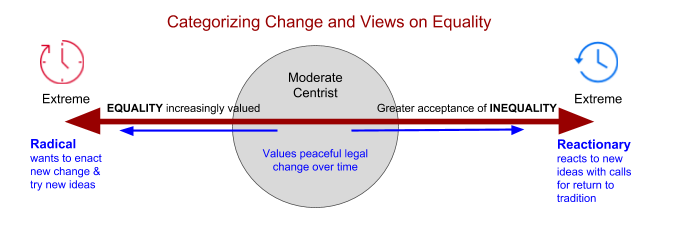
There are other ways to categorize these ideologies. Some organize these different belief systems in a grid. See below:
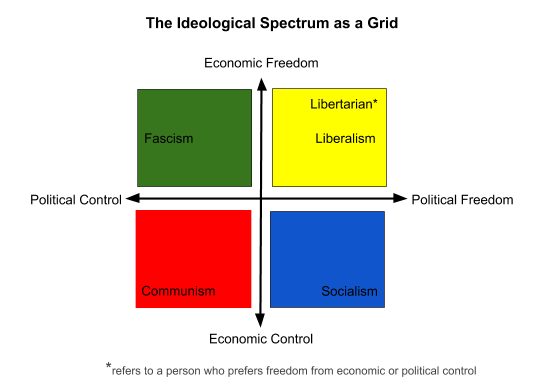
Another way to present differing ideologies is through an arc. Pay careful attention to the labels on each axis or line.
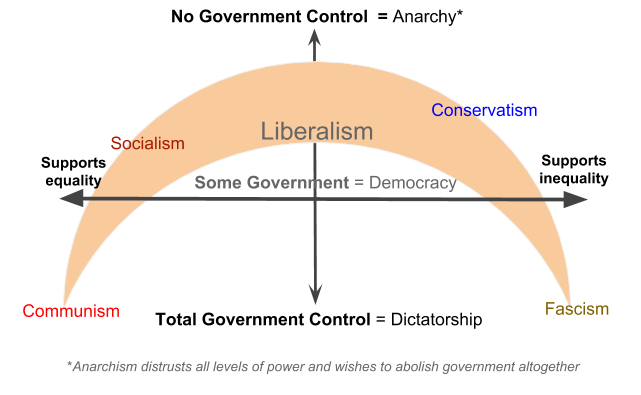
Communism is one ideology that values extreme collectivism both politically and economically. Communism was the ideology of the former Soviet Union, and is the main ideology practiced in Cuba, North Korea, and Laos today. Today, China and Vietnam are communist countries politically, but both countries practice some form of capitalism economically. Later in this course, you will consider communism in more detail, especially in regard to its political and economic characteristics.

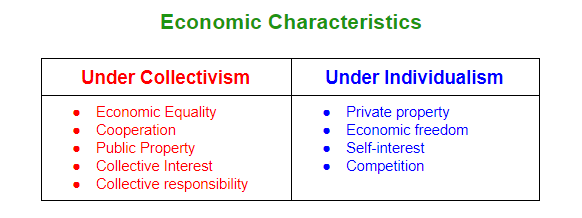
The extreme left favours greater equality of all people, including acceptance of multiculturalism, while the extreme right supports maintaining the status quo, or how things were "in the good old days", including the promotion of one distinct national culture. The centre represents a moderate position that may range from moderate left to moderate right. Moderates may support change on some issues while resisting it on others.
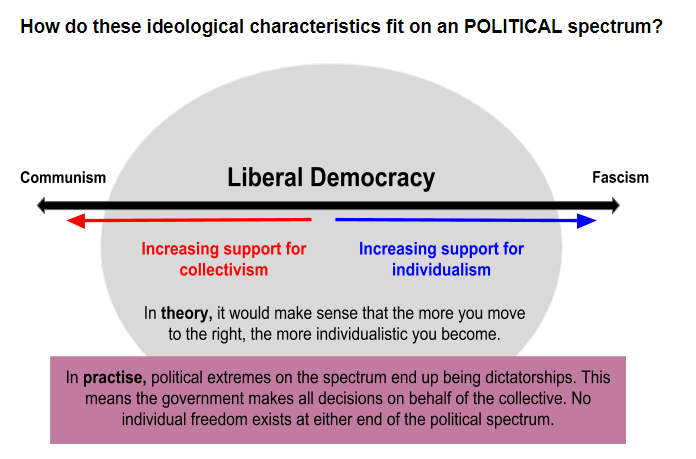
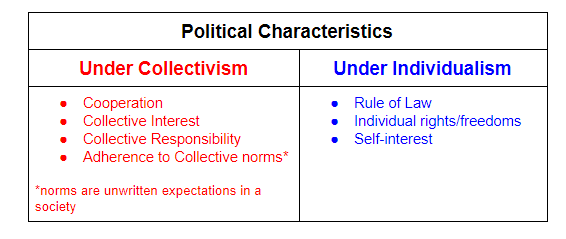
Fascism is a nationalistic and racist ideology that calls for the development of a racially pure nation. It resulted in the totalitarian state of Nazi Germany, in which the government controlled almost every aspect of peoples' lives. You will learn more about fascism as an extreme right-wing political ideology in Nazi Germany later in the course.


17. Individualism as an Ideology
Individualism as an Ideology

- Do you think about a perfect world where each person has the chance to live his or her dreams?
- Do you think about a world where everyone competes and many fail with no one to help them ?
- What about a society in which people are free to make the most of their own decisions, but also free to establish rules and programs to help those in need?
Consider the quote on the T-shirt:
- Is the ideological perspective more individualist or collectivist?
- Do you agree with the perspective that is reflected on the T-shirt?
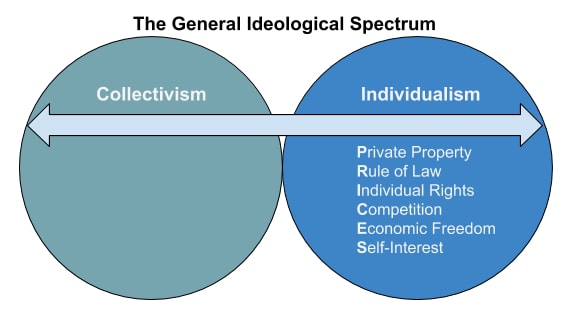


Capitalism is an economic system that takes many forms. It is based on a belief in competition, private property, and the value of obtaining wealth.
Canada, the United States, and most democratic nations believe in capitalism.
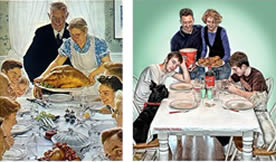
Conservatism is an ideology based on preserving society as it is, without making change towards greater freedom or equality. Conservatives tend to believe in following traditional values. Within every country, there are individuals who are more conservative than others.
There are many different types of conservatives. Some may call themselves financially (fiscally) conservative, while others would say they are socially conservative.

All democratic nations today are liberal to some extent.
Key in liberalism is a belief in individual freedom in political and economic affairs. Today, all democratic nations are liberal to some extent.

Most capitalist nations support a degree of consumerism.
18. Collectivism as an Ideology
Collectivism as an Ideology
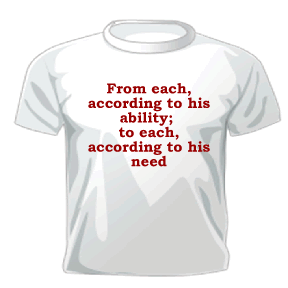
- ...a highly controlled communist state where private property is illegal and citizens have few freedoms?
- ...a communal society where people live in harmony and share their wealth?
- ...a society in which people are free to make most of their own decisions but also contribute to the common good through taxation?
Consider the quote on the T-shirt:
- How does it reflect collectivist principles?
- Do you agree with the perspective that is reflected on the T-shirt?
Using the diagram below, review the principles of collectivism introduced on page 1.3.3. It is imperative you understand and can apply these principles in subsequent tasks.

It is very challenging to study ideologies, as they tend to evolve over time. Two societies may call themselves socialist, but they will slightly differ depending on their practice. Some countries may place greater emphasis on some collectivist principles, while other more extreme ideologies like communism, will prioritize every principle above individual rights and freedoms. Despite their emphasis, these collectivist principles can be found in all left wing ideologies. We study the following ideologies in subsequent units.
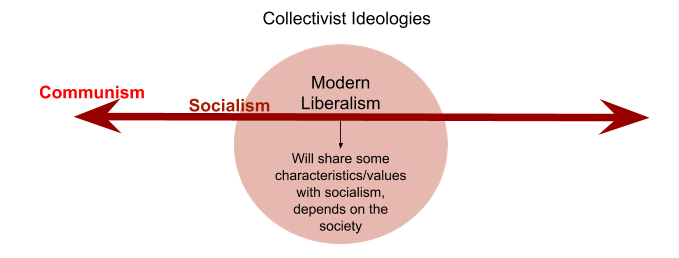

The ideology was founded on the ideas of Karl Marx, who believed that history revealed a cycle of oppression, where the owners of production exploited the working poor. Marx believed that the workers of the nation must rise up and take power through revolution to establish a truly equal and classless society.
In practice, communist states have been unsuccessful both economically and politically. You will study communism in Unit Three and Six.
The title to the image above is 'Berlin Falls to Communism'.

However, many countries today practise what is known as social democracy or democratic socialism. These are democratic countries in which people vote for changes to the economic structure so that there will be greater equality.
This can include greater taxes for the rich, more social programs to help the disadvantaged, and the nationalization of resources.
To differing degrees, both Canada and Sweden are social democracies. This will be studied in greater depth during Unit Six.
19. The Common Good
Me and We: The Common Good

A person who believes strongly in putting personal interests ahead of everything else can still contribute to the good of society. A person who believes strongly in supporting common goals is still an individual with his or her own interests, values and personality. Each citizen develops their own ideology or set of beliefs about how to best achieve the common good.
Analyze the perspective on the T-shirt to the left.
- What ideological perspective does it represent? Individualism, collectivism, or both?
- How do you know?
The common good refers to the good of society as a whole. Most individuals and nations share some collective interests. People in more individualistic societies also contribute to the common good. For example, in Canada's democracy, we have political parties that hold different ideas on how to best achieve the common good.
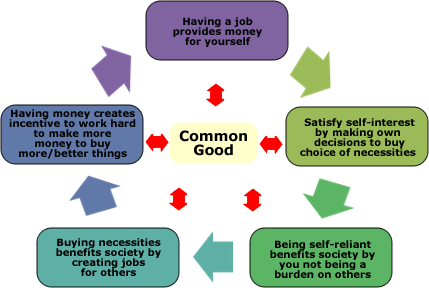
Where are Canadians in terms of ideology?
Although we are all individuals with our own views, we are also members of Canadian society. Canada is a democracy, and Canadian citizens vote for the political party that best represents their own views. As a nation, we have agreed that this is the best approach to decision-making. We vote and then agree to follow the direction the elected governments take.In Canada, many government actions are for the common good. Universal health care, public education, paved roads, national and provincial parks, various police forces, and countless social programs benefit society at large. Although not everyone has a child in school, visits a park, or receives social assistance, we have agreed that these programs make a better country for everyone. This ideology reflects modern liberal values, an ideology you will study later on in this course.
What is the cartoonist trying to say about government laws that prohibit smoking in public areas?

What do these pie graphs tell you about Canadian government practice and collectivism?

|
This graph shows that post-secondary education is funded mostly by the tuition fees of students, donations from past students, and research grants from corporations looking for a profit.
|

|
This graph shows that health care is funded mostly through taxpayers dollars.
|
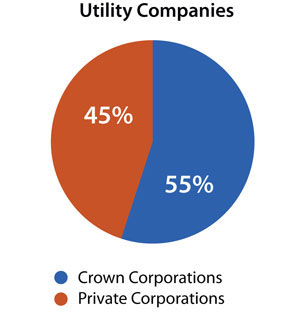
|
This graph shows that utilities are almost half and half funded by the government and the private sector.
|
20. SUMMARY
Unit One Summary
Unit 1 explores ideologies and their impact on identity.
You learned about the themes and characteristics of an ideology.
Themes |
|---|
|
Characteristics |
|---|
|
- Rule of law
- Individual Rights and Freedoms
- Private Property
- Economic Freedom
- Self-Interest
- Competition
- Economic Equality
- Co-operation
- Public Property
- Collective Interest
- Collective Responsibility
- Adherence to Collective Norms
- Socialism
- Communism
- Liberalism
- Capitalism
- Fascism
Classical liberalism is primarily an individualistic ideology based on the principles of individualism. It produced many positive changes, but it resulted in challenges also. In the next unit, you will explore the development of classical liberalism, an ideology that came into being as a reaction to events and a result of new ideas about the nature of mankind and how societies should operate.
- How did liberalism originate?

